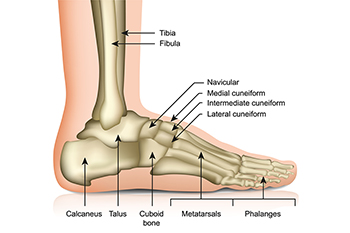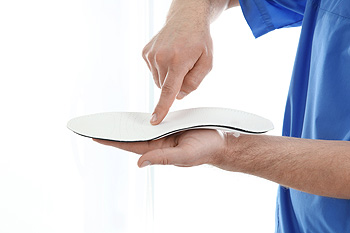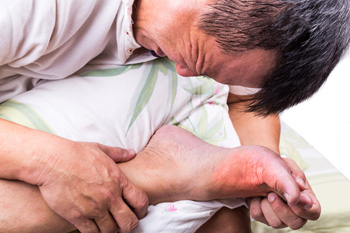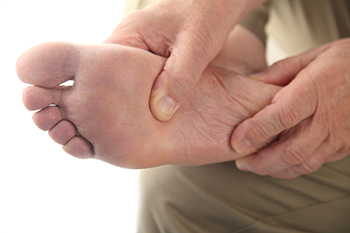Connect With Us
Blog
Items filtered by date: November 2022
How the Ankle Joint Works

One of the key joints in the body is the talocrural region, also known as the ankle joint. This joint, which connects the leg to the foot, is crucial to walking, standing, and running. The main bone in the ankle joint is the talus. Because it is not attached to any muscles, the talus is reliant on the bones surrounding it. Other bones that may be thought of as ankle bones actually belong to the lower leg or foot. These consist of the tibia and fibula of the leg, as well as the calcaneus of the heel and the navicular, which lies on top of the foot. These bones work together with the talus to allow the foot to point and flex. Another main function of the talus is to transmit force from the tibia to the calcaneus, or heel bone. Holding all these bones together is a network of ligaments. Keeping the ankle joint healthy includes wearing footwear that provides ample support and cushioning to avoid chronic ankle pain that can interfere with all your daily activities. If you have any pain or discomfort in the ankle, please visit a podiatrist for an examination and diagnosis.
Ankle pain can be caused by a number of problems and may be potentially serious. If you have ankle pain, consult with Dr. Nicholas Przystawski from Central Florida Foot Care, PA. Our doctor will assess your condition and provide you with quality foot and ankle treatment.
Ankle pain is any condition that causes pain in the ankle. Due to the fact that the ankle consists of tendons, muscles, bones, and ligaments, ankle pain can come from a number of different conditions.
Causes
The most common causes of ankle pain include:
- Types of arthritis (rheumatoid, osteoarthritis, and gout)
- Ankle sprains
- Broken ankles
- Achilles tendinitis
- Achilles tendon rupture
- Stress fractures
- Bursitis
- Tarsal tunnel syndrome
- Plantar fasciitis
Symptoms
Symptoms of ankle injury vary based upon the condition. Pain may include general pain and discomfort, swelling, aching, redness, bruising, burning or stabbing sensations, and/or loss of sensation.
Diagnosis
Due to the wide variety of potential causes of ankle pain, podiatrists will utilize a number of different methods to properly diagnose ankle pain. This can include asking for personal and family medical histories and of any recent injuries. Further diagnosis may include sensation tests, a physical examination, and potentially x-rays or other imaging tests.
Treatment
Just as the range of causes varies widely, so do treatments. Some more common treatments are rest, ice packs, keeping pressure off the foot, orthotics and braces, medication for inflammation and pain, and surgery.
If you have any questions, please feel free to contact our office located in Leesburg, FL . We offer the newest diagnostic and treatment technologies for all your foot care needs.
Types of Orthotics for Different Foot Conditions

Orthotics may help correct specific types of abnormal foot structures. They have been used to find relief with hammertoes and bunions, and are made of different materials for specific foot conditions. Rigid orthotics may be successful in controlling the movement of the feet below the ankle joints, in addition to improving the range of motion. This type of orthotic may be used when the patient has arthritis, high arches, or plantar fasciitis. Existing diabetic foot wounds and foot deformities may be helped by wearing accommodative orthotics, and it may help to improve overall foot function. Semi-rigid orthotics are comprised of soft and rigid materials and are generally used to treat flat feet. Additionally, they have been used to treat children’s disorders such as in-toeing and out-toeing. If you have foot pain, it is strongly advised that you consult with a podiatrist who can determine which type of orthotic is correct for you, and measure your feet correctly for custom-made orthotics.
If you are having discomfort in your feet and would like to try orthotics, contact Dr. Nicholas Przystawski from Central Florida Foot Care, PA. Our doctor can provide the care you need to keep you pain-free and on your feet.
What Are Orthotics?
Orthotics are inserts you can place into your shoes to help with a variety of foot problems such as flat feet or foot pain. Orthotics provide relief and comfort for minor foot and heel pain but can’t correct serious biomechanical problems in your feet.
Over-the-Counter Inserts
Orthotics come in a wide variety of over-the-counter inserts that are used to treat foot pain, heel pain, and minor problems. For example, arch supports can be inserted into your shoes to help correct overarched or flat feet, while gel insoles are often used because they provide comfort and relief from foot and heel pain by alleviating pressure.
Prescription Orthotics
If over-the-counter inserts don’t work for you or if you have a more severe foot concern, it is possible to have your podiatrist prescribe custom orthotics. These high-quality inserts are designed to treat problems such as abnormal motion, plantar fasciitis, and severe forms of heel pain. They can even be used to help patients suffering from diabetes by treating foot ulcers and painful calluses and are usually molded to your feet individually, which allows them to provide full support and comfort.
If you are experiencing minor to severe foot or heel pain, it’s recommended to speak with your podiatrist about the possibilities of using orthotics. A podiatrist can determine which type of orthotic is right for you and allow you to take the first steps towards being pain-free.
If you have any questions please contact our office located in Leesburg, FL . We offer the newest diagnostic and treatment technologies for all your foot and ankle needs.
Pregnancy and Fluid Retention

When a woman carries a baby to term during pregnancy, her body undergoes a variety of different physical changes. Many of these changes concern the feet. If you are expecting, you might consider being especially mindful of the extent to which the pregnancy might be affecting fluid retention in the feet and lower legs. For example, during pregnancy, blood circulation to the feet may be diminished, which can cause excess fluid retention. Certain factors may increase one’s susceptibility to this condition. Namely, consuming food that is high in salt and exercising may increase a pregnant woman’s fluid retention and result in swollen feet. Please contact a podiatrist if you are concerned about fluid retention in the feet during pregnancy.
Pregnant women with swollen feet can be treated with a variety of different methods that are readily available. For more information about other cures for swollen feet during pregnancy, consult with Dr. Nicholas Przystawski from Central Florida Foot Care, PA. Our doctor will attend to all of your foot and ankle needs.
What Foot Problems Can Arise During Pregnancy?
One problem that can occur is overpronation, which occurs when the arch of the foot flattens and tends to roll inward. This can cause pain and discomfort in your heels while you’re walking or even just standing up, trying to support your baby.
Another problem is edema, or swelling in the extremities. This often affects the feet during pregnancy but tends to occur in the later stages.
How Can I Keep My Feet Healthy During Pregnancy?
- Wearing orthotics can provide extra support for the feet and help distribute weight evenly
- Minimize the amount of time spent walking barefoot
- Wear shoes with good arch support
- Wear shoes that allow for good circulation to the feet
- Elevate feet if you experience swelling
- Massage your feet
- Get regular, light exercise, such as walking, to promote blood circulation to the feet
If you have any questions please feel free to contact our office located in Leesburg, FL . We offer the newest diagnostic and treatment technologies for all your foot and ankle needs.
Heel Pain Can Be Treated!
Causes and Risks of Gout

Gout is a form of arthritis that results in joint pain and swelling in the joints and frequently attacks the big toe. Gout is caused by a buildup of uric acid in the blood that forms crystals in the joints. If ignored, gout can result in serious health issues affecting the kidneys and may permanently damage the joints. The main cause of high uric acid in the blood is that it is not being flushed out properly. Genetics is thought to be the number one contributor to this. Other factors include underlying health issues and side effects of certain medication. You may be at higher risk of developing gout if you are overweight, have high blood pressure, and eat foods rich in purines. Men over 40 and women in menopause are also at greater risk of developing gout. If you have two or more gout attacks in your toe within a year, it is a good idea to contact a podiatrist. A number of medical treatments are available to keep the uric acid levels down. Changes to diet and weight reduction may also be recommended.
Gout is a painful condition that can be treated. If you are seeking treatment, contact Dr. Nicholas Przystawski from Central Florida Foot Care, PA. Our doctor will treat your foot and ankle needs.
What Is Gout?
Gout is a form of arthritis that is characterized by sudden, severe attacks of pain, redness, and tenderness in the joints. The condition usually affects the joint at the base of the big toe. A gout attack can occur at any random time, such as the middle of the night while you are asleep.
Symptoms
- Intense Joint Pain - Usually around the large joint of your big toe, and it most severe within the first four to twelve hours
- Lingering Discomfort - Joint discomfort may last from a few days to a few weeks
- Inflammation and Redness -Affected joints may become swollen, tender, warm and red
- Limited Range of Motion - May experience a decrease in joint mobility
Risk Factors
- Genetics - If family members have gout, you’re more likely to have it
- Medications - Diuretic medications can raise uric acid levels
- Gender/Age - Gout is more common in men until the age of 60. It is believed that estrogen protects women until that point
- Diet - Eating red meat and shellfish increases your risk
- Alcohol - Having more than two alcoholic drinks per day increases your risk
- Obesity - Obese people are at a higher risk for gout
Prior to visiting your podiatrist to receive treatment for gout, there are a few things you should do beforehand. If you have gout you should write down your symptoms--including when they started and how often you experience them, important medical information you may have, and any questions you may have. Writing down these three things will help your podiatrist in assessing your specific situation so that he or she may provide the best route of treatment for you.
If you have any questions, please feel free to contact our office located in Leesburg, FL . We offer the newest diagnostic and treatment technologies for all your foot care needs.
Checking for Cuts on the Bottom of Feet

It is beneficial for people who have diabetes to take extra precautions where their feet are concerned. This can contribute significantly to reducing the risk of getting a diabetic foot ulcer. This can develop as a result of the inability to feel existing cuts and scrapes on the feet, which is generally caused by neuropathy. It is beneficial for diabetic patients to check the bottom of their feet daily, and this can be successfully done by using a mirror. They may also be checked by a caregiver or family member, if applicable. There are symptoms that are typically noticed in people who have diabetes that can include swollen feet, a burning or achy sensation, and wounds that will not heal. Some patients develop blisters on their feet that they are unaware of, and can easily become infected. It is suggested that all weight is taken off of the foot if there is an existing wound, in addition to seeking immediate care with a podiatrist who can effectively treat and manage diabetes.
Diabetic foot care is important in preventing foot ailments such as ulcers. If you are suffering from diabetes or have any other concerns about your feet, contact Dr. Nicholas Przystawski from Central Florida Foot Care, PA. Our doctor can provide the care you need to keep you pain-free and on your feet.
Diabetic Foot Care
Diabetes affects millions of people every year. The condition can damage blood vessels in many parts of the body, especially the feet. Because of this, taking care of your feet is essential if you have diabetes, and having a podiatrist help monitor your foot health is highly recommended.
The Importance of Caring for Your Feet
- Routinely inspect your feet for bruises or sores.
- Wear socks that fit your feet comfortably.
- Wear comfortable shoes that provide adequate support.
Patients with diabetes should have their doctor monitor their blood levels, as blood sugar levels play such a huge role in diabetic care. Monitoring these levels on a regular basis is highly advised.
It is always best to inform your healthcare professional of any concerns you may have regarding your feet, especially for diabetic patients. Early treatment and routine foot examinations are keys to maintaining proper health, especially because severe complications can arise if proper treatment is not applied.
If you have any questions please feel free to contact our office located in Leesburg, FL . We offer the newest diagnostic and treatment technologies for all your foot and ankle needs.

